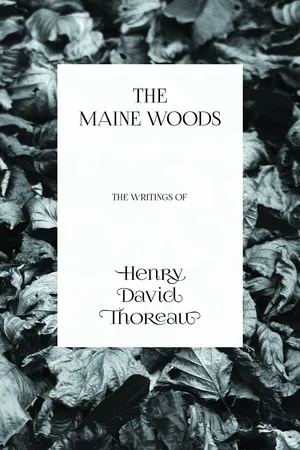
- 293 pages
- English
- ePUB (mobile friendly)
- Available on iOS & Android
The Maine Woods - The Writings of Henry David Thoreau
About This Book
"The Maine Woods" is the third volume in "The Writings of Henry David Thoreau" series. It is a fantastic collection of essays written by Henry David Thoreau during numerous visits to the Maine woods. A charming combination of prose, poetry, and scientific fact, "The Maine Woods" will appeal to all nature lovers and would make for a worthy addition to any collection. Henry David Thoreau (1817 – 1862) was an American poet, philosopher, essayist, abolitionist, naturalist, development critic, and historian. He was also a leading figure in Transcendentalism, and is best known for his book "Walden", a treatise on simple living in a natural environment. Other notable works by this author include: "The Landlord" (1843), "Reform and the Reformers" (1846–48), and "Slavery in Massachusetts" (1854). Contents include: "Henry David Thoreau", "Introductory Note", "Ktaadn, "Chesuncook", "The Allegash And East Branch", and "Appendix". Many vintage books such as this are becoming increasingly scarce and expensive. We are republishing this volume now in an affordable, modern, high-quality edition complete with a specially commissioned new biography of the author.
Frequently asked questions
Information
Table of contents
- Henry David Thoreau
- INTRODUCTORY NOTE
- KTAADN
- CHESUNCOOK
- THE ALLEGASH AND EAST BRANCH
- APPENDIX